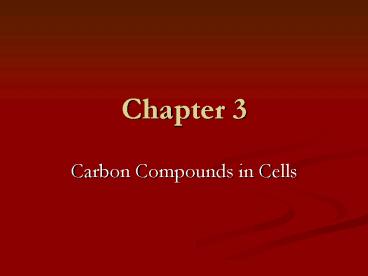Carbon Compounds in Cells - PowerPoint PPT Presentation
1 / 19
Title:
Carbon Compounds in Cells
Description:
These bonds link carbon together in chains that form a backbone to which other atoms can bond. ... Natural fats butter, lard, vegetable oils ... – PowerPoint PPT presentation
Number of Views:35
Avg rating:3.0/5.0
Title: Carbon Compounds in Cells
1
Chapter 3
- Carbon Compounds in Cells
2
Bonding
- Carbon can share pairs of electrons with up to
four other elements. - These bonds link carbon together in chains that
form a backbone to which other atoms can bond.
3
- The backbone can coil into a ring structure that
can be diagrammed like so - Or written
- H C C C C C C H
4
In many cases there are two types of reactions
taking place
- Condensation, where a hydroxyl group from one
molecule and a hydrogen from another molecule
come together and force a bond to form where they
were removed. - Hydrolysis, where an enzyme uses a hydroxyl and a
hydrogen to split a compound into two or more
parts. This cuts large molecules into smaller
ones that can be used for energy.
5
Can form four different types of organic
molecules.
- 1. Carbohydrates
- 2. Lipids
- 3. Proteins
- 4. Nucleic Acids
6
Carbohydrates
- The most abundant of all biological molecules.
- Used as structural material and as an energy
forms. - Made of carbon, hydrogen, and oxygen in the ratio
121 (CH2O)n.
7
Monosaccharides and Disaccharides
- Monosaccharides consist of 1 carbon ring
- Glucose, fructose
- Disaccharides consist of 2 carbon rings
- sucrose
8
Complex Carbohydrates
- Polysaccharide - chains of many monosaccharides
- Examples cellulose, starch, glycogen, chitin
9
- Cellulose plant structural material. (tough,
insoluble) - Glycogen animal sugar storage. Housed largely
in muscle and liver. - Starch plant sugar storage.
- Chitin nitrogen containing polysaccharide main
structural component of insect external skeleton
and outside wall of fungus
10
Lipids
- Made of hydrocarbons that dont readily dissolve
in water. - Greasy or oily to touch.
- Used as a main energy reservoir, structural
materials (cell membranes), and signaling
molecules
11
Unsaturated
- Have one or more double bonds and are liquid at
room temperature
12
Saturated
- No double bonds solid at room temperature. Most
animal fats are saturated.
13
Triglycerides
- Natural fats butter, lard, vegetable oils
- Bodys most abundant lipid and richest energy
source - Stored in body fat tissue (adipose)
- In some animals, it serves as insulation
(penguins)
14
(No Transcript)
15
Phospholipids
- Glycerol backbone, 2 fatty acids and a
hydrophilic head of a phosphate group with a
polar group. - Main material of the cell membrane
16
(No Transcript)
17
Amino Acids
- Most diverse of compounds
- Enzymes speed up metabolic activities.
- Move molecules and ions across membranes
(transport). - Protein hormones regulation of cell activities.
- Act as a weapon against disease causing agents.
- Build entire proteins from just 20 amino acids.
18
19
Nucleic Acids
- Include DNA, RNA, and ATP
- Will deal with these in later chapters































